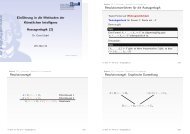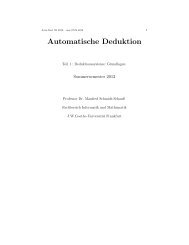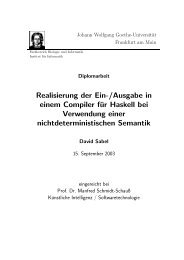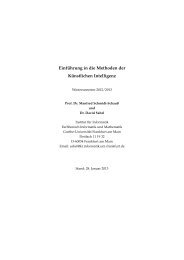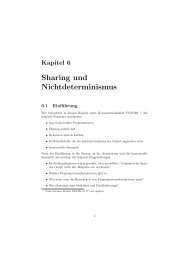Einführung in die Methoden der Künstlichen Intelligenz - Goethe ...
Einführung in die Methoden der Künstlichen Intelligenz - Goethe ...
Einführung in die Methoden der Künstlichen Intelligenz - Goethe ...
Erfolgreiche ePaper selbst erstellen
Machen Sie aus Ihren PDF Publikationen ein blätterbares Flipbook mit unserer einzigartigen Google optimierten e-Paper Software.
Literatur<br />
Allen, J. F. (1983). Ma<strong>in</strong>ta<strong>in</strong><strong>in</strong>g knowledge about temporal <strong>in</strong>tervals. Commun. ACM,<br />
26(11):832–843.<br />
Baa<strong>der</strong>, F., Calvanese, D., McGu<strong>in</strong>ness, D. L., Nardi, D., & Patel-Schnei<strong>der</strong>, P. F.<br />
(2010). The Description Logic Handbook: Theory, Implementation and Applications.<br />
Cambridge University Press, New York, NY, USA, 2nd edition.<br />
Baa<strong>der</strong>, F. & Morawska, B. (2009). Unification <strong>in</strong> the description logic EL. In Proceed<strong>in</strong>gs<br />
of the 20th International Conference on Rewrit<strong>in</strong>g Techniques and Applications,<br />
RTA ’09, pages 350–364. Spr<strong>in</strong>ger-Verlag, Berl<strong>in</strong>, Heidelberg.<br />
Bratko, I. (1990). Prolog – Programm<strong>in</strong>g for Artificial Intelligence. Addison Wesley.<br />
Don<strong>in</strong>i, F. M., Lenzer<strong>in</strong>i, M., Nardi, D., & Nutt, W. (1997). The complexity of concept<br />
languages. Inf. Comput., 134(1):1–58.<br />
Ebb<strong>in</strong>ghaus, H.-D., Flum, J., & Thomas, W. (1986). <strong>E<strong>in</strong>führung</strong> <strong>in</strong> <strong>die</strong> mathematische<br />
Logik. Wissenschaftliche Buchgesellschaft Darmstadt.<br />
E<strong>der</strong>, E. (1992). Relative Complexities of First or<strong>der</strong> Calculi. Vieweg, Braunschweig.<br />
Gal, A., Lapalme, G., Sa<strong>in</strong>t-Dizier, P., & Somers, H. (1991). Prolog for Natural Language<br />
Process<strong>in</strong>g. John Wiley & sons.<br />
Haken, A. (1985). The <strong>in</strong>tractability of resolution. Theoretical Computer Science, 39:297–<br />
308.<br />
Michalewicz, Z. (1992). Genetic Algorithms + Data Structures = Evolution Programs.<br />
Spr<strong>in</strong>ger, 3 edition.<br />
M<strong>in</strong>sky, M. (1975). A framework for represent<strong>in</strong>g knowledge. In P. H. W<strong>in</strong>ston, editor,<br />
The Psychology of Computer Vision, pages 211–277. McGraw-Hill, London.<br />
Nebel, B. (1997). Solv<strong>in</strong>g hard qualitative temporal reason<strong>in</strong>g problems: Evaluat<strong>in</strong>g<br />
the efficiency of us<strong>in</strong>g the ord-horn class. Constra<strong>in</strong>ts, 1(3):175–190.<br />
Nebel, B. & Bürckert, H.-J. (1995). Reason<strong>in</strong>g about temporal relations: a maximal<br />
tractable subclass of allen’s <strong>in</strong>terval algebra. J. ACM, 42(1):43–66.<br />
Pereira, F. C. & Shieber, S. M. (1987). Prolog and Natural-Language Analysis. CSLI.<br />
Rob<strong>in</strong>son, J. A. (1965). A mach<strong>in</strong>e-oriented logic based on the resolution pr<strong>in</strong>ciple.<br />
Journal of the ACM, 12:23–41.<br />
M. Schmidt-Schauß & D. Sabel, Skript KI, WS 2012/13 Stand: 30. Januar 2013



